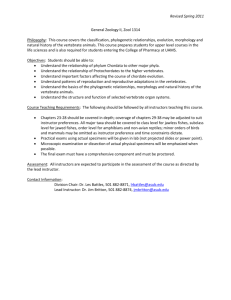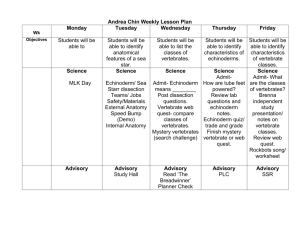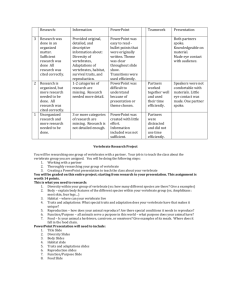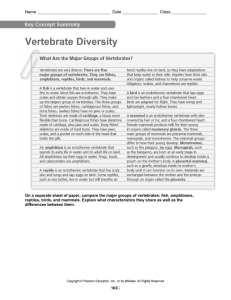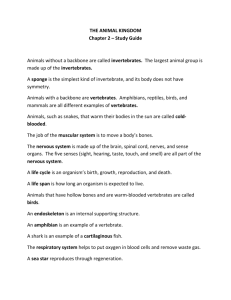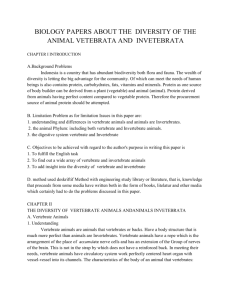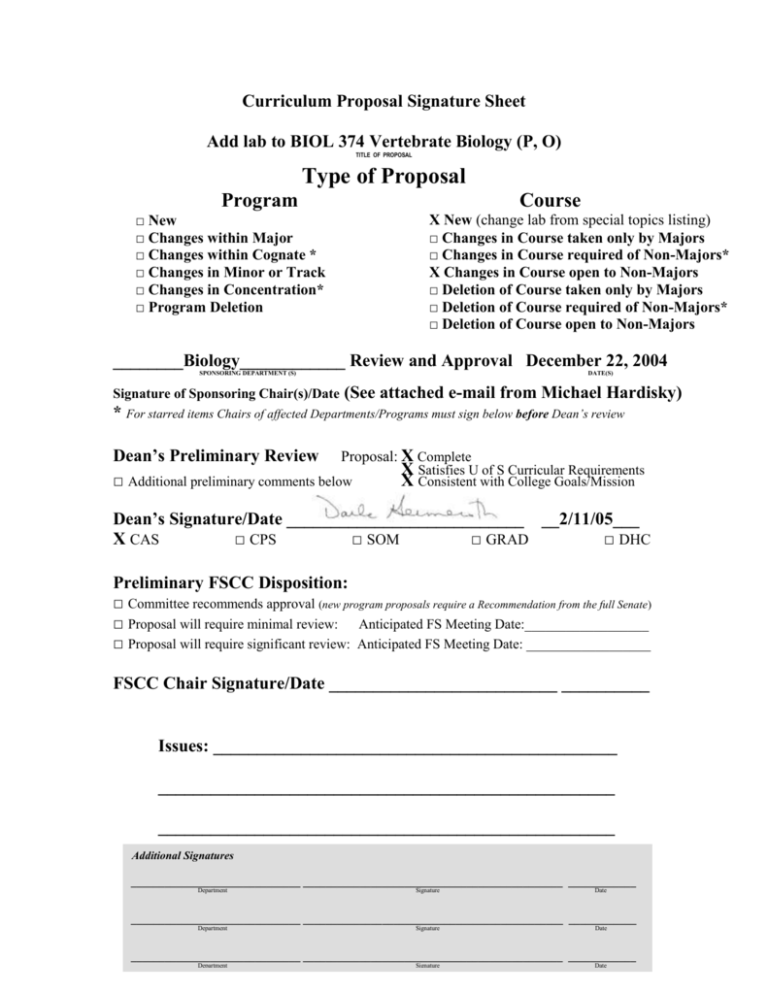
Curriculum Proposal Signature Sheet
Add lab to BIOL 374 Vertebrate Biology (P, O)
TITLE OF PROPOSAL
Type of Proposal
Program
□ New
□ Changes within Major
□ Changes within Cognate *
□ Changes in Minor or Track
□ Changes in Concentration*
□ Program Deletion
Course
X New (change lab from special topics listing)
□ Changes in Course taken only by Majors
□ Changes in Course required of Non-Majors*
X Changes in Course open to Non-Majors
□ Deletion of Course taken only by Majors
□ Deletion of Course required of Non-Majors*
□ Deletion of Course open to Non-Majors
________Biology____________ Review and Approval December 22, 2004
SPONSORING DEPARTMENT (S)
Signature of Sponsoring Chair(s)/Date
DATE(S)
(See attached e-mail from Michael Hardisky)
* For starred items Chairs of affected Departments/Programs must sign below before Dean’s review
Dean’s Preliminary Review Proposal: X Complete
X Satisfies U of S Curricular Requirements
□ Additional preliminary comments below
X Consistent with College Goals/Mission
Dean’s Signature/Date ___________________________ __2/11/05___
X CAS
□ CPS
□ SOM
□ GRAD
□ DHC
Preliminary FSCC Disposition:
□ Committee recommends approval (new program proposals require a Recommendation from the full Senate)
□ Proposal will require minimal review: Anticipated FS Meeting Date:__________________
□ Proposal will require significant review: Anticipated FS Meeting Date: __________________
FSCC Chair Signature/Date __________________________ __________
Issues: ______________________________________________
____________________________________________________
____________________________________________________
Additional Signatures
______________________________ ______________________________________________ ____________
Department
Signature
Date
______________________________ ______________________________________________ ____________
Department
Signature
Date
______________________________ ______________________________________________ ____________
Department
Signature
Date
New Course
Course Title: __Vertebrate Biology Laboratory______________________________________
Course Number:___Biol 374L____________ Date Of Initial Offering: _Spring 2006____
Semester
Rationale for
Course level
year
This course is designed to accompany Vertebrate Biology Lecture (Biol 374). Both of
these courses require students to synthesize information and to think critically about
various topics. Further, in addition to learning identification and taxonomy of a large
number of vertebrates, this course will require students to design research projects, and to
collect, analyze, present and interpret data describing vertebrate morphology,
ecophysiology and behavior.
Credit Hours: _2__ Format: lecture XX lab other:__________________________________ Frequency:
XX annual each semester alternate years
Prerequisites: ___Biol 141-142____________________________________________________________
Rationale for
pre-requisites
(if prerequisites
are listed)
Catalog
Description
(50 word
maximum)
Similar
Courses being
offered at the
University
Discuss
Extent of
overlap with
existing
courses
This course is designed for biology majors. The course covers and integrates a broad
array of biological topics, including evolutionary and systematic biology, ecophysiology,
ecology, behavior and conservation biology, hence a basic understanding of biology is
required. As such, students should have taken Biology 141 and 142.
BIOL 374
5 cr.
Vertebrate Biology (P,O)
(Prerequisites: BIOL 141-142) This course presents an overview of the
vertebrates, placing vertebrate form and function within an ecological and
evolutionary context. Much of the course is concerned with vertebrate
systematics, factors governing distribution, vertebrate interactions with both biotic
and abiotic components of their environment as well as conservation and
management issues. Three hours lecture, three hours lab. Spring only.
None
Special
Resources
Required
(e.g. library,
equipment,
materials/
facilities)
6 field trips which will require the rental of vehicles to transport students. Required
readings will be placed in the Library’s Electronic Reserves and other supplementary
material will be available to students via Blackboard. The course requires access to
museum specimens which have been borrowed specimens from the Natural Academy of
Sciences (Philadelphia) and the Everhart Museum (Scranton). Dr. Smith is in the process
of building a collection to be housed at the University of Scranton.
Characteristics (check any/all that apply):
Major:
GE :
Required
XX Elective
submitted to CCC XX will be submitted to CCC simultaneous with FSCC Area Free only
Humanities (CA)
Humanities (CH)
Humanities (CL)
Humanities (CF)
Interdisciplinary: YES XX NO
S/B Sciences (S)
Cultural Diversity (D)
Natural Science (E)
XX Writing Intensive(W)
Theology/Phil (P)
Quantitative Reasoning (Q)
Team Teaching: YES XX NO
Exclusively For Special Programs/Concentrations: NO YES (Name)____________________
Home College: XX CAS
PCPS
KSOM
GRAD
Required Attachments:
XX Syllabus with student learning objectives, assessment/evaluation mechanisms, and outline of
topics
XX Description of, or example of, readings/papers/projects/examinations
XX Assessment/evaluation based course improvement mechanisms
Vertebrate
Biology Lab
Time/Location:
Tuesday from 1:00 pm – 3:50 pm, Loyola 226
Instructor:
Dr. Robert Smith
Assistant Professor of Biology
Loyola 208
Phone: 941-6581
Email: smithr9@scranton.edu
Office Hours:
Thursday 4:00 – 5:00 pm, Friday 3:00 – 4:00 pm. Additional appointment times are
available upon request. I am here to help you do well in this course, come and see me if
you have questions or concerns!
Course Description:
This course will combine the study of preserved specimens in the laboratory with field trips
to teach students identification, taxonomic relationships and natural history of
representative vertebrate species. Our focus will be primarily on those vertebrates found in
northeastern Pennsylvania. Field trips are planned to observe vertebrates in the wild, in
captivity (Nay Aug Park, Philadelphia Zoo) and as museum specimens (Everhart Museum,
possibly Philadelphia Academy of Natural Sciences). Students will also conduct field
research projects to better understand the behavioral ecology and ecophysiology of selected
vertebrates.
Student Learning Objectives:
Upon completion of this course, students will/will be able to:
1. Identify the commonly occurring vertebrates in northeastern Pennsylvania.
2. Use field guides and dichotomous keys to identify vertebrates.
3. Be familiar with techniques used to identify, capture, handle and collect data from both
aquatic and terrestrial vertebrates.
4. Write field notes summarizing field trips and data collection efforts.
5. Collect, record and analyze data describing vertebrate morphology and behavior using
various techniques and instrumentation.
6. Have a better understanding of how computers are used in the study of biological
phenomena.
7. Present data in the form of a scientific paper.
Required Materials:
Peterson, R.T. 2002. A Field Guide to the Birds of Eastern and Central North America
(Peterson Field Guide Series), 5th edition. Houghton Mifflin Co. ISBN: 0395740460.
Page L.M. et al. 1998.
A Field Guide to Freshwater Fishes : North America North of
Mexico (Peterson Field Guide Series), 2nd edition. Houghton Mifflin Co. ISBN:
0395910919.
Conant et al. 1998. A Field Guide to Reptiles & Amphibians of Eastern & Central North
America (Peterson Field Guide Series), Revised edition. Houghton Mifflin Co. ISBN:
0395904528.
Pechenik, J.A. 2004. A Short Guide to Writing About Biology, 5th Edition. Pearson
Longman, ISBN 0-321-15981-0. A previous edition of this work is sufficient.
Field notebook
Attendance:
Attendance on field trips will count toward part of your final grade. Field trips are an
important component of this course, and are necessary to observe living vertebrates in their
habitats. Be prepared to go into the field on days of scheduled field trips. To minimize
exposure to poison ivy, biting insects, and the sun, your field gear should consist of shoes
and pants that completely cover the feet and legs, a long-sleeved shirt, and a hat.
Depending on the weather, you might also wish to bring a jacket or raincoat. Sunscreen
and insect repellent are also suggested items. Be prepared to go to the field on days field
trips are scheduled. In other words, be ready for any type of weather, as field trips will
only be canceled or postponed if weather is truly severe.
Evaluation Methods:
Student outcome will be assessed via two practical examinations, three lab reports,
completion of field notebooks, and attendance/participation.
Grading:
Course grades will be determined by performance on the following assignments:
Practical exams (2)
100 pts. each
Lab reports (3)
50 pts. each
Fieldnotes (6)
5 pts. each
Attendance/participation
20 pts.
TOTAL
400 pts.
Percentage
93 – 100
90 – 92
87 – 89
83 – 86
80 – 82
77 – 79
Grade earned
A
AB+
B
BC+
Percentage
73 – 77
70 – 72
67 – 69
60 – 66
< 60
Grade earned
C
CD
DF
I have no tolerance for cheating. Students are expected to know and follow the University of
Scranton policies concerning academic honesty.
Tentative Lab Schedule
Class
Meeting
1
Topic/Activity
Introduction, Taxonomy, Anatomy and Identification: fish, amphibians
2
Taxonomy, Anatomy and Identification: fish, amphibians
3
Taxonomy, Anatomy and Identification: fish, amphibians
Practice Field Notes Due
*** Practical Exam # 1 ***
4
5
Taxonomy, Anatomy and Identification: fish, amphibians, reptiles, birds
6
Taxonomy, Anatomy and Identification: fish, amphibians, reptiles, birds, mammals
7
8
9
Human Lab; study design, scientific writing, data entry and analysis
*** Cumulative Practical Exam # 2 ***
Squirrel lab; study design, scientific writing, data entry, figures and analysis
Human Lab Field Notes Due
10
Fieldtrip #1: vertebrate watching, Nay Aug park
11
Fieldtrip #2: Vertebrate watching, Amphibians/reptiles/mammals
Human Lab Due
Field Notes for squirrel lab due
Squirrel Paper Due
Fieldtrip #3: All day (Saturday) trip to Philadelphia Zoo
12
Field trip #4 and Bird Lab: Vertebrate field sampling techniques – bird netting
13
14
Field trip #5: Vertebrate watching, Amphibians/reptiles/mammals
Field trip #6: Vertebrate field sampling techniques – seine fish
Field Notes for Fieldtrip #1 and #2 Due
Field Notes for Fieldtrip #4 Due.
Bird Lab Due Last Day of Finals Week
Field Notes for Fieldtrip #5 due Last Day of Finals Week
Description of projects and examinations
Research Projects: Students will complete 3 research projects through the course of the semester.
Projects will be focused on introducing students to all phases of scientific research. For each
project, students will be presented with a basic outline that includes background information on the
vertebrate of interest and the goals of the research. Topical primary literature articles will be
placed on reserve at the library and students will be required to find additional literature articles to
use in their reports. We will spend time in class designing the study and discussing data collection
methodology appropriate for addressing research goals. Students will then collect and analyze
data, ultimately producing a report.
Report requirements and classroom instruction will be focused on teaching students to write a
scientific paper. The first report will concentrate on production of an Introduction and Results
section. As part of this first report students will learn to produce effective tables and use computer
software to produce figures. The second and third reports will require students to produce a
document that includes an Introduction, Methods, Results and Discussion section. For each report
I will provide extensive written feedback.
Examinations: Students will spend significant time during the early part of the semester examining
preserved specimens to learn identification and taxonomic relationships among vertebrates. To
evaluate their performance, I plan 2 traditional practical examinations. These timed exams require
students to visit a number of discrete stations that contain one or more vertebrates. At each station
students are allotted 2 minutes to answer questions about the identification and/or taxonomy of the
specimen in question.
Assessment/evaluation based course improvement mechanisms
In all my courses I routinely interact with students to obtain feedback on their perception of how
the course is progressing. Further, at the end of the course I ask students to complete a course
evaluation. Finally, I routinely discuss and receive input from faculty colleagues about how I
might improve my courses. I consider modifications to subject matter and my teaching approach
based on both student and colleague input.
-------- Original Message -------Subject:Re: Vert lab course proposal
Date:Wed, 09 Feb 2005 10:43:11 -0500
From:Michael Hardisky <Hardiskym1@Scranton.edu>
Organization:University of Scranton
To:Darla Germeroth <germerothd1@scranton.edu>
References:<420A1FBC.2070401@scranton.edu>
Hi Darla,
The department approved the Vertebrate lab via E-mail vote on 22 December 2004.
Mike




